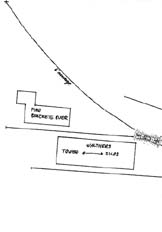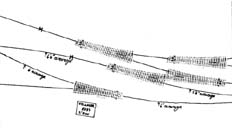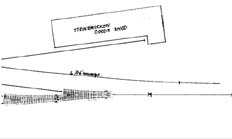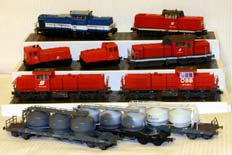


Yet another development of the Colton Junction principles of layout and operation, I'm afraid! This time though the location is Austria, on the outskirts of Vienna. The principles of operation will remain much the same as those of Dave's original layout. The operations will be carried out by modern Austrian-outline diesel locos and the headshunt lengths will be dictated by the stock in use. The trackplan is below and (just like the rest of the 'site) you can click on each of the boards to see a larger view.
 |
Alte Strasse | |
 |
 |
|
Before commiting the trackplan to paper, Dave and I firmed up the trackwork by laying out some representative examples of points and plain track on baseboards being built for his new On30 American layout - watch this space for that one! By doing this we were able to show that the chosen trackplan would fit into a smaller area than that intended to be used. This means I can create a better illusion of space, which is otherwise difficult with tall buildings like cement silos.
This layout will be split into two 'zones' as far as operation is concerned. The left hand half of the layout consists of a cement silos and concrete mixing/bagging facility - both rail served. This part of the layout will be operated using a number of Klein Modellbahn Uacs bogie cement wagons. The cement works itself runs under the ownership of the Holcim company (they actually do have a facility near Vienna), so there are a number of Holcim branded rail and road vehicles. The cement works will be shunted by locomotives of either the WLB or LTE companies; both have, at different times, operated trains for Holcim in reality.
The other half of the layout (on the right) is operated as a freight forwarding yard. In this case the locomotives in use are all ÖBB types. Stock consists of a small number of vehicles from most of the major European manufacturers. Again Klein Modellbahn wagons feature heavily - their various sliding sidewall wagons being a particular favourite.
So that's the rough outline of what it is and how it'll operate. Here's the tricky bit: As you'd expect we're sticking to our usual standards, employing the use of Kadee couplers and DCC. What you may not be expecting is that this layout is being built to use the RP25-88 standard - close to P87. So the pointwork (Peco Code 75) will need rebuilding to tighten up the flangeways. I consider this a worthwhile activity not only for the benefit of the appearance, but also because it should help the running.

To put it simply there are a few good locos (though still too many for the layout!), each of which is protoypical for operation around Vienna. There are three specific shunting locos which will be retained for emergencies, or for 'novice' operators - their small size helps the shunting by giving more length in the headshunts!
Routine operation will use a small number of 'road switcher' types. To help with the operation the traction tyred wheelsets would have ended up being replaced, even if I wasn't replacing the wheels to my chosen standard. All the locos have been re-wheeled, DCC decoders fitted and Kadee couplers installed. Most have had additional details and the odd one or two has been re-motored; a couple even have replacement chassis.
A quick summary of the locos either currently available, in preparation, on order or wanted for the layout:
| Operator | Class | Model Basis | Comments |
|---|---|---|---|
| ÖBB | 2048 (Ex. DB V100) | Roco BR2048 | Black Beetle wheels, Mashima motor. Detailing. Zimo MX61/2000 DCC decoder |
| ÖBB | 2050 | Lima BR2050 | One for the wishlist this. Lima have produced a couple of variations of the 2050 in the later Verkehrsrot (Traffic Red) livery. One of these would be a useful/interesting addition to the fleet as it'd be the only full body loco on the layout - everything else is a centre-cab type. |
| ÖBB | 2060 (shunter) | Liliput (Wien) BR2060 | Custom Black Beetle motor bogie. Detailing. Lenz Gold Mini DCC decoder and Power1 |
| ÖBB | 2062 (shunter) | Kleinbahn BR2062 | Home-brewed chassis using two High-Level gearboxes, Mashima motor and Black Beetle wheels. Detailing and a full paint job. Lenz Gold Mini DCC decoder and Power1 |
| ÖBB | 2067 (shunter) | Lima BR2067, scratchbuilt chassis | Faulhaber motor driving High-Level gearbox. Sprung chassis with Gibson wheels and home made flycranks. Zimo MX620N DCC decoder with small on-board power pack. |
| ÖBB | 2068 | Klein Modellbahn BR2068 | Black Beetle wheels, Mashima motor. Detailing. Not yet decided on the decoder but the Zimo MX620R seems likely |
| ÖBB | 2070 (Vossloh G800) |
Trix BR2070 | Black Beetle wheels. Detailing. Zimo MX620R DCC decoder. A very, very impressive product from Trix - I've got both of the ÖBB versions |
| Wiener Lokalbahn (WLB) | ADtranz rebuild of Ex-DR V100 | Brawa WLB 92 | Black Beetle wheels. Detailing. Zimo MX620R DCC decoder. More weight! |
| LTE | 2150.9 (Vossloh G1206) |
Mehano LTE red G1206 | Black Beetle wheels, probably. Detailing, maybe. Zimo MX620R DCC decoder, I guess. I've been impressed with Mehano's recent products - this one is on order and I'm looking forward to it arriving! |
| LTE | 2170 (Vossloh G1700-2) |
Mehano or Piko LTE G1700 | The first manufacturer to do a model of LTE's 2170 001-8 gets my money - any takers? |
The hyperlinks in this couple of paragraphs and the table link out to the relevant pages in this website. It shows how all the bits we do kinda knit together...